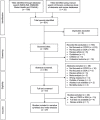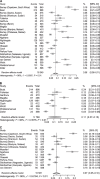Chronic obstructive pulmonary disease in sub-Saharan Africa
- PMID: 35197163
- PMCID: PMC8886964
- DOI: 10.5588/ijtld.21.0394
Chronic obstructive pulmonary disease in sub-Saharan Africa
Abstract
BACKGROUND: Chronic obstructive pulmonary disease (COPD) is the third leading cause of death worldwide and an important cause of death in sub-Saharan Africa (SSA). We conducted a systematic review and meta-analysis on the prevalence of and risk factors for COPD in SSA.METHODS: We conducted a protocol-driven systematic literature search in MEDLINE, EMBASE, CINAHL and Global Health, supplemented by a manual search of the abstracts from thoracic conference proceedings from 2017 to 2020. We did a meta-analysis of COPD prevalence and its association with current smoking.RESULTS: We identified 831 titles, of which 27 were eligible for inclusion in the review and meta-analysis. The population prevalence of COPD ranged from 1.7% to 24.8% (pooled prevalence: 8%, 95% CI 6-11). An increased prevalence of COPD was associated with increasing age, smoking and biomass smoke exposure. The pooled odds ratio for the effect of current smoking (vs. never smoked) on COPD was 2.20 (95% CI 1.62-2.99).CONCLUSION: COPD causes morbidity and mortality in adults in SSA. Smoking is an important risk factor for COPD in SSA, and this exposure needs to be reduced through the combined efforts of clinicians, researchers and policymakers to address this debilitating and preventable lung disease.
CONTEXTE :: La bronchopneumopathie chronique obstructive (COPD) représente la troisième cause de décès dans le monde et une cause importante de décès en Afrique subsaharienne (SSA). Nous avons réalisé une revue systématique et une méta-analyse de la prévalence et des facteurs de risque de COPD en SSA.
MÉTHODES :: Nous avons réalisé une analyse systématique de la littérature déterminée par un protocole, en utilisant les bases de données MEDLINE, EMBASE, CINAHL et Global Health, complétée d’une recherche manuelle des résumés des conférences sur les maladies respiratoires de 2017 à 2020. Nous avons réalisé une méta-analyse de la prévalence de la COPD et de son association avec le tabagisme.
RÉSULTATS :: Nous avons identifié 831 titres, dont 27 étaient éligibles à l’inclusion dans la revue et la métaanalyse. La prévalence de la COPD dans la population générale variait de 1,7% à 24,8% (prévalence groupée : 8%, IC 95% 6–11). La prévalence de la COPD augmentait avec l’âge, le tabagisme et l’exposition aux fumées dégagées lors de la combustion de la biomasse. L’odds ratio groupé pour l’effet du tabagisme actuel (vs. personnes n’ayant jamais fumé) sur la COPD était de 2,20 (IC 95% 1,62–2,99).
CONCLUSION :: La COPD est à l’origine d’une morbidité et d’une mortalité chez les adultes en SSA. Le tabagisme est un facteur de risque important de COPD en SSA. Cette exposition doit être réduite grâce aux efforts conjoints des cliniciens, chercheurs et responsables politiques afin de s’attaquer à cette maladie pulmonaire évitable et invalidante.
Conflict of interest statement
Conflicts of interest: none declared.
Figures





References
-
- Haplin DMG, et al. It is time for the world to take COPD seriously: a statement from the GOLD board of directors. Eur Respir J. 2019;54:1900914. - PubMed
-
- Vesto J, et al. Global strategy for the diagnosis, management and prevention of Chronic Obstructive Pulmonary Disease. GOLD Executive Summary. Am J Respir Crit Care Med. 2013;187(4):347–365. - PubMed
-
- Meghji J, et al. Improving lung health in low-income and middle-income countries: from challenges to solutions. Lancet. 2021;397(10277):928–940. - PubMed
-
- Halpin DMG, et al. The GOLD Summit on chronic obstructive pulmonary disease in low- and middle-income countries. Int J Tuberc Lung Dis. 2019;23(11):1131–1141. - PubMed
-
- Dalal S, et al. Non-communicable diseases in sub-Saharan Africa: what we know now. Int J Epidemiol. 2011;40(4):885–901. - PubMed
Publication types
MeSH terms
Substances
Grants and funding
LinkOut - more resources
Full Text Sources
Medical
Research Materials

